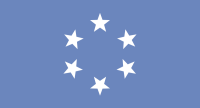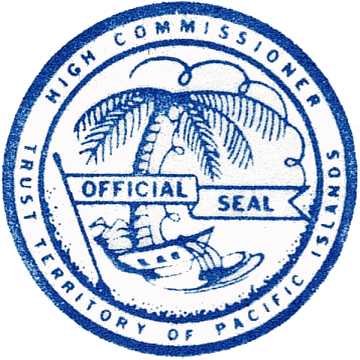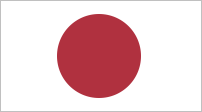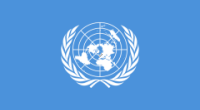 US Postage Stamps
// Philatelic Project
// Micronesia
US Postage Stamps
// Philatelic Project
// Micronesia
 US Postage Stamps
// Philatelic Project
// Micronesia
US Postage Stamps
// Philatelic Project
// Micronesia

|
Micronesia
UN Trust Territory of the Pacific Islands (TTPI) |

|
|
After the end of the Pacific War[1] the
Micronesian
archipelagos, Mariana Islands (except Guam Island), Caroline Islands, and Marshall Islands, became the UN[2] Trust Territory of the Pacific Islands (TTPI) on July 18, 1947. The UN trusteeship replaced the League of Nations'[3] South Pacific Mandate effective on June 28, 1919, and under administration of the Japanese Empire from December 17, 1920 until US military forces occupied Guam and Saipan (Mariana Islands) in June/July 1944.
The UN Security Council delegated the administration of the TTPI to the United States of America, effective July 18, 1947. Until 1951 the TTPI was administered by the US Navy based in Guam, afterwards by the US Department of the Interior from a base in Saipan until the US administration ended on November 3, 1986. The UN Security Council formally ended the trusteeship for Mariana Islands, Caroline Islands (Islands of Chuuk, Yap, Kosrae, Pohnpei), and Marshall Islands districts on December 22, 1990. Finally the trusteeship for the Palau District (Western Caroline Islands) ended on May 25, 1994. |
||
|
The following political entities evolved out of the TTPI's districts:
Commonwealth of the Northern Mariana Islands, unincorporated US territory, established between 1976/1986 Republic of the Marshall Islands, constitutional government established on May 1, 1979, independence under COFA[4] on October 21, 1986 Federated States of Micronesia, constitutional government established on May 10, 1979, independence under COFA[4] on November 3, 1986 Republic of Palau, constitutional government established on January 1, 1981, independence under COFA[4] on October 1, 1994 |
||


|
[1] The Pacific War, part of World War II, started with a military strike of the Imperial Japanese Navy against the US naval base Pearl Harbor, located on O'ahu Island, US Territory of Hawai'i, on December 7, 1941. The war ended with the unconditional surrender of the Japanese Empire on September 2, 1945 after the US Air Force dropped an atomic bomb on the Japanese cities of Hiroshima (August 6, 1945) and Nagasaki (August, 9, 1945). | |

|
[2] The United Nations Organization was established after World War II on 24 October, 1945 in New York, NY, USA, by fifty-one member states, and was the successor organization of the League of Nations[3]. | |

|
[3] The League of Nations (predecessor institution of the UN[2]) was established after World War I on June 28, 1919 by fourty-four member states, administrative center was based at the Palace of Nations in Geneva, Switzerland. | |

|
[4] Free association with the United States of America under the Compact of Free Association (COFA). The USA provide defence, funding grants and access to US social services for citizens of the associated State. | |
|
Republic of the Marshall Islands
[Aolepān Aorōkin M̧ajeļ] Majuro // Micronesia // Marshall Islands Time (MHT) |
|
| UN trusteeship: | July 18, 1947 - December 22, 1990 |
| US administration: | July 18, 1947 - November 3, 1986 |
| Constitutional government established: | May 1, 1979 |
| Independence under COFA[4]: | October 21, 1986 |
| UN admittance: | September 17, 1991 |
| Inauguration of MH Postal Service: | May 2, 1984 |
| View map of the Marshall Islands | |
|
Federated States of Micronesia
Palikir // Micronesia // Pohnpei (PONT) and Yap (YAPT/CHUT) Time |
|
| UN trusteeship: | July 18, 1947 - December 22, 1990 |
| US administration: | July 18, 1947 - November 3, 1986 |
| Constitutional government established: | May 10, 1979 |
| Independence under COFA[4]: | November 3, 1986 |
| UN admittance: | September 17, 1991 |
| Inauguration of FM Postal Service: | July 12, 1984 |
| View maps of the Federate States of Micronesia | |
|
Republic of Palau
[Beluu er a Belau] Ngerulmud // Micronesia // Palau Time (PWT) |
|
| UN trusteeship: | July 18, 1947 - May 25, 1994 |
| US administration: | July 18, 1947 - November 3, 1986 |
| Constitutional government established: | January 1, 1981 |
| Independence under COFA[4]: | October 1, 1994 |
| UN admittance: | December 15, 1994 |
| Inauguration of Palau Postal Service: | March 10, 1983 |
| View map of the Republic of Palau | |
|
|
The Republic of Palau is an island state formed out of the westernmost portion of the Caroline Islands in the North Pacific Ocean, including the larger islands of Angaur, Babulthuap, Eil Malk, Koror, Peleiu and
Urukthapel. Most of the ca. 350 islands are small low-lying coral islets, surrounded by barrier reefs. The exception is the largest island, the mountainous Babulthuap Island of volcanic origin. The Palau Constitution designates sixteen traditional municipalities of Palau as states. The nation's capital, Ngerulmud is located in the State of
Melekeok on the east coast of Babulthuap Island.
The official languages are English and Palauan. The official currency is the US dollar (USD, US$). The Rock Island Southern Lagoon, Koror State, has been inscribed on the UNESCO World Heritage List in 2012. |
||

|
Land Area
rounded mi2 [km2] 177 [458] Coast line 944 mi [1,519 km] |
Population
(2012 estimate) 21,030 |
Population Density
per mi2 [km2] of land area 119 [46] |
| // Elmar R. Göller // All rights reserved // Contact // Publishing Information |
| modified |